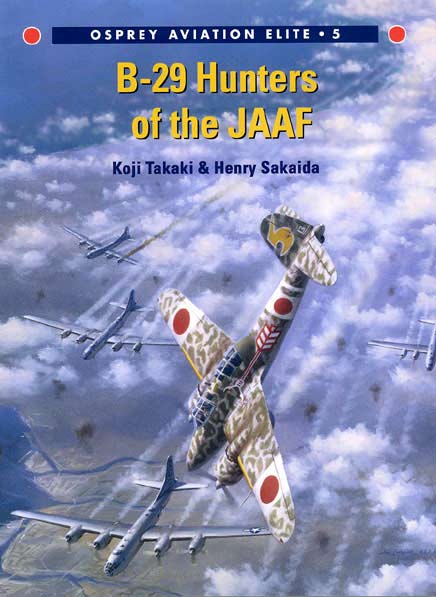BOOK REPORT
B-29 HUNTERS OF THE JAAF
OSPREY AVIATION ELITE - 5
 Publisher: Osprey Publishing Author: Koji Takaki & Henry Sakaida |
| 34 Beautifully illustrated scaled drawings of Japanese aircraft in color by Mark Styling. |

The illustration above is color plate # 9 of 34. The aircraft is a Ki-61-I-Tei.
Flying at high altitudes, and devastating targets with both high explosives and incendiaries, the Superfortresses conducted very long range missions from recently captured island bases in the western Pacific. Although ill-equipped to defend the home islands, the Japanese Army Air Force threw itself ito the task wholeheartedly. Fighter sentai initially attempted to repel the B-29s through conventional means, but pilots soon realized that the bomber was virtually impossible to shoot down using these tactics. As a final resort, units formed specialist ramming flights, and these proved highly successful up until the arrival of the USAAF escort fighters in April 1945. Detailing some of the most remarkable aerial engagements of the war this volume reveals the huge sacrifice made by the JAAF in the final year of the war as it fought in vain to defend Japan.
By 1944 the war was going badly for the Japanese. The first B-29 attacks against Japan came from China-Burma-India theatre. B-29s were stripped of weight, and due to the long distance fuel problems forced them to carry small bomb loads. The Japanese were waiting and ready, with night fighters and searchlights, and anti-aircraft guns. The Japanese also had an early warning Radar network which kept them well informed. On August 20, 76 B-29s took off to bomb the iron and steel factories at Yawata. They were met by intense flak, and over 100 fighter planes. This raid produced the first ramming by Japanese aircraft. This mission was completed with 17 enemy fighters shot down, 13 probables, and 12 damaged. 14 B-29s were lost and 8 damaged by flak. The battle between the B-29s and the Japanese fighters was on. Immediately Americans were aware of the Japanese pilots great exaggerations of kills. This continued throughout the conflict. There is no doubt the ramming tactics and suicide attacks were a force to be reckoned with.
By the end of March 1945, the XX Bomber Command had ceased operation from the CBI. The XX1 Bomber Command was now ready to carry the fight to the Japanese homeland operating from recently captured islands in the Marianas. In Japan ramming units were activated. At 27,000 ft. the jet stream affected the bombing accuracy and raid after raid was determined to be ineffective. The targets were aircraft factories. The Kamikaze attacks by the Japanese increased and were quite effective. When Curtis LeMay took over the XX1st Bomber Command he ordered the B-29s to go in at lower altitudes at night, and not in formation. Using less gas, they could carry a larger bomb load. LeMay also started using incendiaries and systematically started bombing virtually every city in Japan. As the bombing runs increased so did the ramming which had become a real nightmare for the B-29s. The Japanese pilots were desperate, realizing the war was lost, and wanted to sacrifice themselves for the glory and honor which would be bestowed on them and their families. As the bombing altitudes got lower the number of B-29s in the attacks increased to where every day hundreds of them were destroying Japanese cities.
Japanese techniques against the Americans were becoming worrisome. In one technique the fighter would climb above the bomber formation and drop breakaway canister aerial burst phosphorous bombs. This proved very effective. Also the "Dragon Killer" night fighters were fitted with twin mounted 20mm cannons angled to shoot up. The idea was to coordinate their attack with ground searchlights, and approach the bombers from below, then shoot up into the formation. Most times they were never even seen. The war continued to deteriorate for the Japanese as the first long range P-51 escorts showed up to mark the beginning of the end for Japanese aviation.
 DRAGON KILLER CANNONS
DRAGON KILLER CANNONS Firebombing had incinerated nearly every city in Japan. American aircraft could now roam almost at will over Japan. The last ramming took place on 26 June 1945 against 426 B-29s. The Enola created a dramatic ending to the bloody conflict which the Japanese had started. The Japanese surrendered on 15 Aug. 1945.
This fine publication goes into sickening detail of the treatment the Japanese gave our captured B-29 crewmembers. Most were beheaded as soon as they were captured. Perhaps the Atomic bomb was justified considering the fanatical character of our enemy, and the unforgettable, unforgivable treatment of our POWs.
Every man who ever flew as a crewmember on a B-29 should definitely read this book. It is full of photos of B-29 crashes, listing the names of American and Japanese crews. It is literally an encyclopedia of the B-29 final slaughter of the fanatical Japanese, and the end of the Japanese Empire. I consider this book a must have.
Book report written by Wayland Mayo, Website Historian